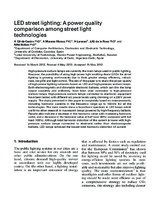LED street lighting: A power quality comparison among street light technologies

Ver/
Autor
Bollen, M.H.J.
Larsson, A.
Moreno-Muñoz, A.
González de la Rosa, Juan José
Gil-de-Castro, Aurora
Editor
SAGE PublicationsFecha
2012Materia
LED street lightingMETS:
Mostrar el registro METSPREMIS:
Mostrar el registro PREMISMetadatos
Mostrar el registro completo del ítemResumen
High-pressure sodium lamps are currently the main lamps used in public lighting.
However, the possibility of using high-power light emitting diode (LEDs) for street
lighting is growing continuously due to their greater energy efficiency, robustness,
long life and light control. The aim of this paper is to study the power quality
of high-power lighting networks based on LED and high-pressure sodium lamps.
Both electromagnetic and dimmable electronic ballasts, which can dim the lamp
output smoothly and uniformly, have been used connected to high-pressure
sodium lamps. High-pressure sodium lamps connected to electronic equipment
have been tested with different arc power levels using dimming on a 230V power
supply. The study presented in this paper is completely based on measurements,
including harmonic currents in the frequency range up to 150 kHz for all the
technologies. The main results show a broadband spectrum in LED lamps which
confirms other research in Fuorescent lamps powered by high-frequency ballasts.
Results also indicate a decrease in the harmonic value with increasing harmonic
order, and a decrease in the harmonic value at half load (60%) compared with full
load (100%). Although total harmonic distortion of the current is lower with highpressure
sodium lamps connected to electronic rather than electromagnetic
ballasts, LED lamps achieved the lowest total harmonic distortion of current
